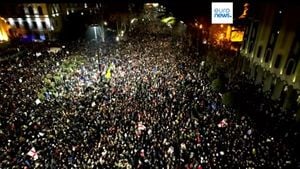The conflict between Ukraine and Russia has entered another intense phase as recent reports highlight severe losses on the Russian side during attempts to recapture the Kursk region. Over the past few days, Russian forces have reportedly faced significant setbacks, with the killing of nearly 2,000 soldiers daily as they attempt to regain lost territory and strength.
Ukrainian officials have emphasized the situation remains under Ukrainian control, as their troops showcase resilience against what has become Russia's largest counteroffensive since the onset of the invasion. Ukrainian Defense Forces have effectively managed to withstand waves of Russian attacks, leading to catastrophic losses for the adversary.
On November 11, the General Staff of the Armed Forces of Ukraine communicated the staggering figure of 1,950 Russian soldiers lost during failed offensive attempts. "It was truly a black day for the Russian occupiers who tried to storm with multiple waves," remarked Anastasia Blyshchyk, spokesperson for Ukraine's 7th Separate Mechanized Brigade. The continuous assault has been described as reckless, often leading Russian armored vehicles and accompanying infantry straight to heavily fortified minefields and drone attacks.
Since Ukraine launched its counteroffensive operations back in August, they have successfully captured numerous settlements, compelling Russian President Vladimir Putin to escalate reinforcements. Recent intelligence suggests about 50,000 troops, including 8,000 to 11,000 North Korean soldiers, have been deployed to the Kursk area, with the Kremlin seeking to retake space lost to Ukrainian advances.
Initially, Putin set October 1 as the deadline to regain control of Kursk. This goal has not been met, prompting renewed commitment from Moscow. The Russian plan involved advancing through two distinct routes: one leading toward Malaya Loknya and another from Novoivanovka. Strategic control over this area would give the Russians greater influence over nearby Ukrainian positions and facilitate more extensive operations along the frontlines.
Yet, reports indicate the Russian force buildup lacks the potency necessary for breakthroughs. The Institute for the Study of War (ISW) indicates the Russian military's inability to amass enough forces capable of securing meaningful advances. Combat analysis shows diminished morale among Russian troops fueled by persistent casualties, which have reportedly tripled their numbers from the summer months to current levels.
Ukrainian commanders, preparing for these attacks, anticipated Russian strategies and have placed significant emphasis on utilizing anti-tank mines and drones along planned routes. This preparation has paid dividends, evidenced as Russian units reportedly lost up to two-thirds of their armored vehicles during misguided assaults. Drastic losses were noted when about 15 BTRs and over 150 soldiers from the 810th Marine Brigade advanced toward Ukrainian strongholds, quickly becoming victims of the pre-planned defensive measures.
Some combat footage released by Ukrainian forces illustrated the number of Russian armored units breaching minefields, with several vehicles rapidly destroyed by Ukrainian fire as their infantry was left heavily exposed. Reports noted as many as 18 of 29 assault vehicles were reportedly obliterated during battles near Novoivanovka, with intelligence asserting heavy losses on the Russian side.
On the other hand, the addition of North Korean troops to Russian ranks raises eyebrows. Training and deployments suggest the North Koreans have been integrated operationally, with increasing evidence surfacing of their involvement at the frontlines. The presence of North Korean machine guns was discovered on the battlefield, hinting at their deepening role within the Russian military strategy.
Despite the tough terrain and shifting dynamics, Ukrainian forces laud their command structure and the experience held tightly among their ranks, allowing them to grip the frontlines securely. General insights from various military analyses portray Ukrainian identification of the Russian command's hesitance to adapt battle strategies as severely hampering their operational effectiveness.
According to Admiral Sir Tony Radakin's insights, Ukrainian military efforts are not only maintaining control but are also actively disrupting Russian regaining efforts across various regions. He noted, "The pain and suffering caused by Putin’s intentions is being paid for by the Russian youth, many of whom never return from the battlefield."
Publicly, neither side has fully disclosed their official tally of losses; yet credible analyses estimate approximately 700,000 casualties among Russian personnel since the start of the conflict, with about half of those being fatalities.
Ukraine, facing relentless waves from Russian commands, isn't slowing down. They’re gearing up with the support of military assistance from international allies, focusing on future operations to secure the proposals set by Kyiv’s leadership for any potential negotiations. Meanwhile, the Kremlin persists with military strategies, hoping for last-minute gains before the probable incoming political changes expected from the outcome of elections across the Atlantic.
The struggle over Kursk, underscored by its historical significance and geopolitical stakes, highlights not only the armed confrontation but paints the broader ambitions and narratives portrayed by both nations. Analysts remain cautiously optimistic about the undeterred vigor of the Ukrainian military as they withstand the earth-shattering clashes we become increasingly familiar with on the news daily. Returning to battlefield reports, indicators showcase the artillery still echoing within Kursk’s periphery, reflecting the intensity of this chilling war, as both sides brace for whatever lies ahead.



